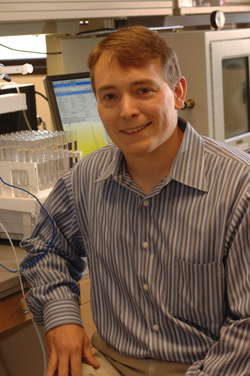
Craig Lindsley, Ph.D., came to Vanderbilt from Merck.
Photo by Anne Rayner
Industry influx helps boost drug discovery capabilities
Vanderbilt University Medical Center is fast becoming an “engine” of drug discovery.
During the past four years, the Medical Center has received large grants from the federal government and private sector and made major investments of its own to develop strong capabilities in high-throughput screening, synthetic chemistry and structure-based drug design.
About a dozen new faculty members have been recruited during the same period by the departments of Pharmacology, Chemistry and Biochemistry, and by the Vanderbilt Institute of Chemical Biology (VICB). Half of them were recruited from industry.
One of them, Craig Lindsley, Ph.D., arrived from Merck this fall. The young chemist has accumulated an impressive resume since earning his doctorate from the University of California, Santa Barbara in 1996.
Lindsley was lead author of a report in Bioorganic & Medicinal Chemistry Letters that was the third most downloaded paper published in all of Elsevier's 2,000-plus journals in 2005.
At the time, Lindsley led the technology-enabled synthesis group at Merck's West Point, Pa., facility. Yet he said he saw greater opportunities for pursuing his research at Vanderbilt.
Now an associate professor of Pharmacology and Chemistry, Lindsley followed fellow Merck alum Jeff Conn, Ph.D., who directs VICB's Program in Drug Discovery and the Pharmacology Depart-ment's Program in Translational Neuropharmacology.
“Vanderbilt's so interested in doing therapeutic drug discovery,” Lindsley said, “it's like building a drug discovery 'engine.'
“We actually can have the luxury of working on targets that are just interesting (and) novel, and … without the time and budget pressures of 'Big Pharma.'”
In collaboration with Carlos Arteaga, M.D., who directs the Specialized Program of Research Excellence (SPORE) in Breast Cancer at the Vanderbilt-Ingram Cancer Center, Lindsley is pursuing the research that got all of those “hits” last year.
The subject of that well-read paper was the discovery and description of “isozyme-selective allosteric inhibitors” of a key signaling molecule called Akt.
Named for a leukemia virus isolated from a particular strain of mice, Akt is a protein kinase, an enzyme that activates other proteins involved in cell growth, survival and proliferation. As such, it is a target for potential cancer drugs.
The problem is that there are three Akt isozymes — enzymes with similar activities but different functions. Blocking all of them can cause serious side effects including hyperglycemia.
Lindsley and his colleagues at Merck took a different tack.
Rather than looking for an inhibitor that bound to the enzyme's primary binding site — its “business end” — the researchers looked for a secondary, “allosteric” site that could modulate the enzyme's activity, much in the same way that a dimmer switch can adjust the intensity of an electric light.
Using high-throughput medicinal chemistry techniques, the researchers found two series of small molecules that selectively “dim” the activity of two Akt isozymes commonly overexpressed in several human cancers including brain, gastric, colon, breast, lung and prostate.
Inhibiting both isozymes resulted in the death of tumor cells grown in culture, they reported.
Clearly, technology is making such research possible, Lindsley said.
“It used to be that you had 18 chemists on a project (each of whom) would make one or two compounds, get data and then make the next one or two,” he said. “Now we're doing 50 to 100 at a time. It's just a much, much faster way of doing medicinal chemistry.”
Last year Vanderbilt opened a new high-throughput screening (HTS) facility, equipped with about $1.5 million worth of computer-controlled, robotically accessible instruments that can test tens of thousands of samples per day for their ability to bind and/or modulate the activity of “target” receptors or enzymes.
Yet Vanderbilt's growing strength in drug discovery is as much due to its brainpower as its computer power, Lindsley said.
Lindsley credited the expertise of Conn and David Weaver, Ph.D., a former Bristol-Myers Squibb scientist who oversees the HTS facility, with providing “a significant competitive advantage” to Vanderbilt, particularly when it comes to discovering new allosteric modulators.
“It's translational,” he said. “It's not just doing biology. It's not just doing chemistry. It's translating basic discoveries all the way up to late pre-clinical, early clinical studies.
“If we develop allosteric modulators and check off all the pre-clinical boxes, I think we're going to find a lot of interest from pharmaceutical partners to license … these compounds and do the clinical development.”













